Introduction
The leader in this market segment is Canon, with its G series competing with Nikon Coolpix’s P series, and more recently with Samsung, a true newcomer. While Canon had good success with its G11, Nikon missed the target —the P6000 did not seduce, mostly because of its so-so image quality. For Samsung, things are easier: they have to make their first entry as perfect as possible to stand a chance in an “expert” and demanding segment. Thus, the Canon G12, the Nikon Coolpix P7000, and the Samsung EX1 were the most anticipated launches for this autumn.
In analyzing these new models, and more precisely the behavior of their (highly similar) sensors, we want to know:
• What do they bring compared to their predecessors?
• What are the differences between our three models?
• How do these models compare with the newly-launched mirrorless cameras?
KEY FEATURES
The three models all have a different history, although their key features are almost identical.
The Canon G11 was a great product, and the G12 largely builds upon it. Sensor size and pixel count remain the same: 10 MP on a 1/1.7” CCD sensor. The major differences between the two generations are that the G12 is now able to record 720p videos, and that Canon added a DSLR-style dial on the right handle.
Nikon also has some experience in the compact domain, although the P6000 was not as good as anticipated. In essence, the P7000 is completely new. Its layout has nothing in common with that of the P6000 (some say that it now looks like a Canon G series camera), and the inside has been completely modified as well. The P6000 had a 13 MP 1/1.7 sensor. The P7000 uses the same kind of 10 MP 1/1.7 CCD sensor as Canon and Samsung.
Although it has an ever-growing selection of cameras, until now Samsung did not have a high-end compact. The EX1 (or TL500 if you live in Northern America) is Samsung’s first model in this category. Samsung chose a safe recipe, using the same 10 MP 1/1.7” CCD sensor as the Canon G series.
Comparing previous versions
When a new model is issued, the first question that arises is what kinds of improvements it brings. The answer is different for each of our three competitors.
For Samsung it’s quite easy, as the EX1 is the first of its kind.
P7000: Nothing in common with the P6000
For Nikon, the P7000 is a big change from the P6000. With its 10 megapixels, the CCD sensor of the P7000 also sees its pixel pitch climbing to 2.1 µm instead of 1.8 µm for the P6000. This helps it achieve a better low-light ISO score, reaching 147 ISO for the P7000…. roughly 14% better than the P6000.
This new heart provides the P7000 with better image quality than the P6000. This evolution is noticeable in all the tested fields—SNR, dynamic range, tonal range and color sensitivity have all improved.
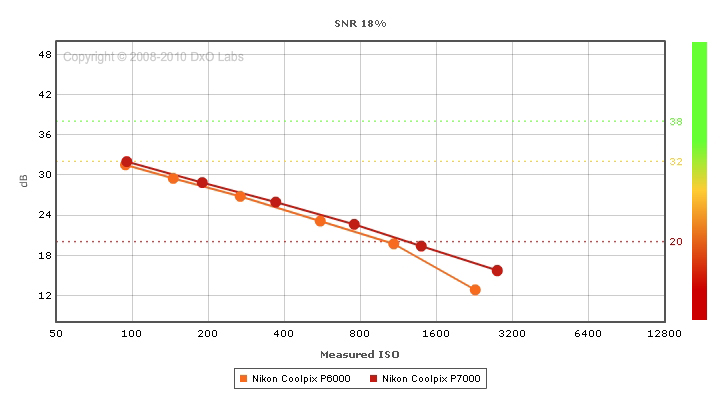
G12: More functions, few improvements in image quality
For Canon, things are a little bit more complicated. The G11 was already very good. For the G12, Canon focused more on adding new functions and on video than on improving image quality. In all tested fields, the metrics are almost the same. People using a G11 should see very few differences with a G12 in terms of picture quality.
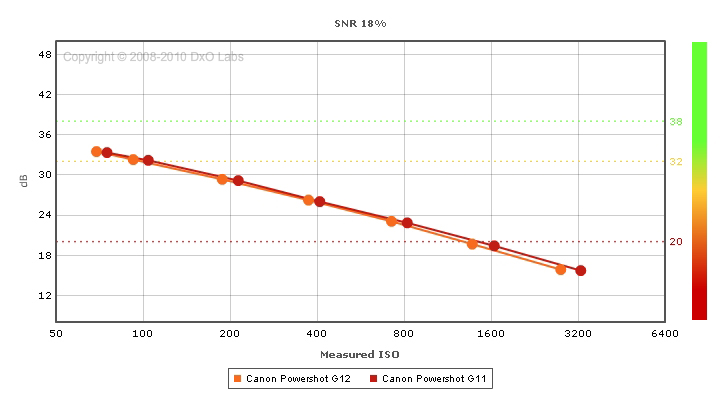
G12 vs P7000 vs EX1: Which is the best ?
The similarities among the three sensors used on each of our three models should normally result in a very close behavior as well.
But starting with the Overall score, differences arise. The G12 is clearly ahead with 47 points, while Samsung and Nikon score respectively 40 and 39 points. Two use cases are in favor of the G12: portrait, with a 20.4-bit color depth (more than 1 bit better than the other two), and low-light ISO, for which the G12 reaches 161 ISO, about 1/3 stop better than the Samsung EX1, with 129 ISO.
When we analyze the metrics, the close performance behavior of all the competitors is obvious, with SNR, dynamic range and tonal range being very close from one model to another.
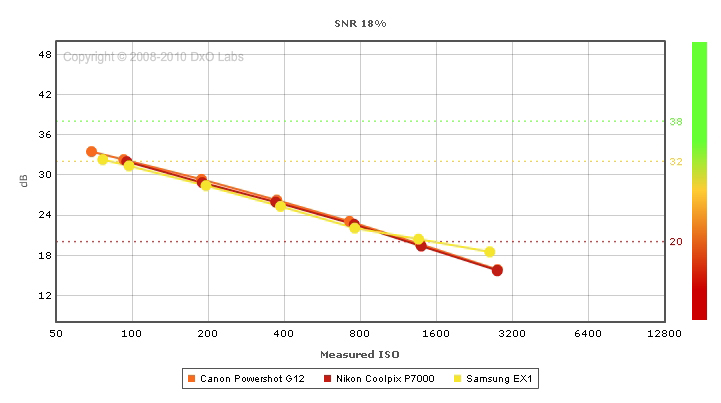
The three curves are almost identical. The G12 has a slight advantage, especially in low ISO, where it is the only one to remain above 32 dB.
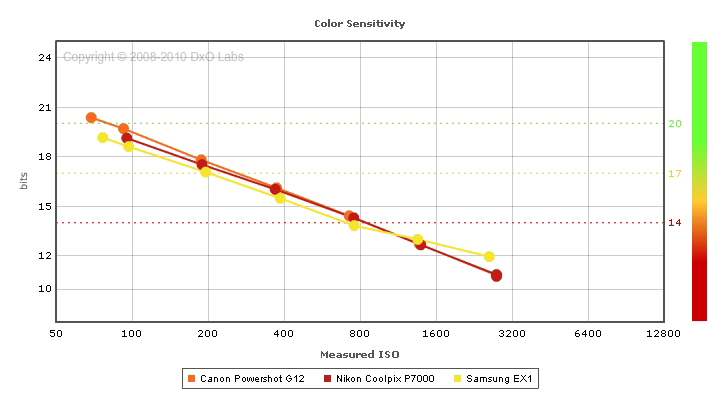
Here the G12 has a clear advantage over its competitors, especially at 100 ISO and below, where its sensor is 1 bit ahead of the others. This is the only metric for which the G12 differs from the others. Tonal range and dynamic range metrics are almost identical for the three cameras.
In summary, the three cameras show very similar behavior, although the G12 has some slight advantage for very low ISO and a greater advantage for color sensitivity.
Expert compacts?
The three pocket-sized cameras are among the best in their category. Their biggest problem today is that the sensor is compact-sized, too. The more noticeable improvements between the previous and the newest models (G11 compared to G12 and P6000 to P7000) concern mostly the layout and the handling of the device more than the image quality itself.
The newly-launched mirrorless bodies, with their much bigger sensors, provide much better results than these cameras with smaller sensors. This is true for almost all measurable areas, and especially as you increase ISO sensitivity. Moreover, a bigger sensor allows both a higher pixel count (usually 14 megapixels for a mirrorless APS-C) and a pixel pitch two times larger.
Let’s look at how a Samsung NX10 with its APS-C sensor behaves compared to a Canon Powershot G12. Both cameras are in the same price range; the NX10 is a little bit bulkier.
Let’s start with the SNR value analysis because it gives good insight into image quality. Less noise means a better picture. In this respect, the bigger sensor of the NX10 does a better job, being almost 5 dB above that of the G12 no matter the ISO setting. To better understand this result, keep in mind that the SNR value given in dB is algorithmic. Increasing it by 6dB results means doubling the amount of noise (equal to 2 stops of ISO sensitivity). The NX10 APS-C sensor produces only about half the noise as the G12 at any ISO setting.
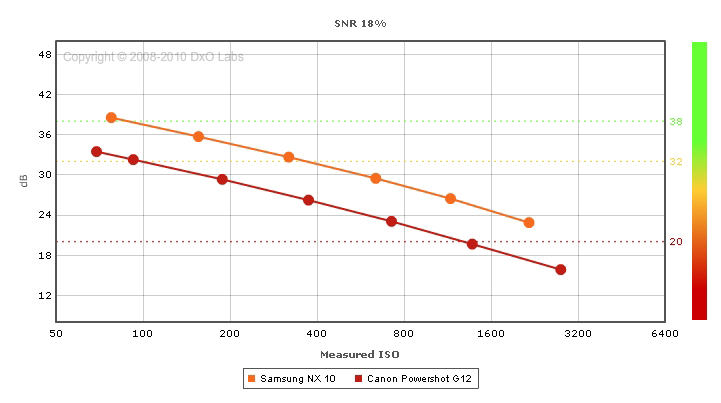
The SNR chart is crystal clear: the APS-C sensor of the Samsung stays roughly 5 dB above the Canon, no matter the ISO value.
The Samsung NX10 stays above 30 dB (which means a very good amount of detail) up to 400 ISO, while the G12 has to stay at 100 or below for the same SNR.
Dynamic range, too, is clearly a domain in which the bigger NX10 sensor performs well, although the G12 still shows very good results below 150 ISO. But if you increase sensitivity, once again the APS-C rules.
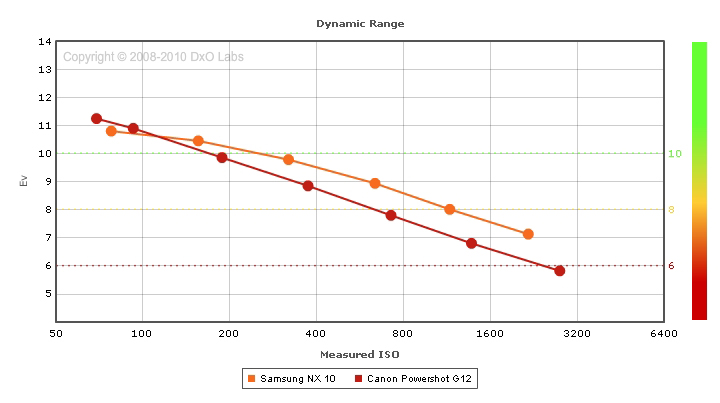
The G12 performs very well below ISO 200. Above this, however, the APS-C sensor of the NX10 is almost 1Ev ahead.
Let’s finish this short comparison with the color sensitivity chart. Here again, no surprise: the NX10 APS-C sensor outperforms the smaller G12 sensor. The most interesting point is that this superiority increases with ISO: from 0.5 bit at lower sensitivities, it climbs above 1 bit at the end of the range.
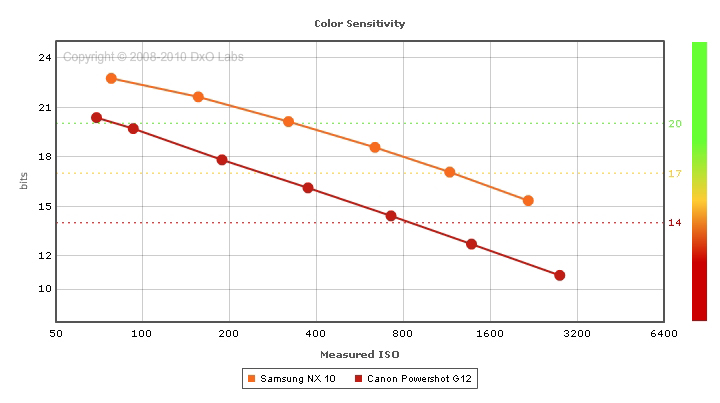
The NX10 is 0.5 bit ahead at lower ISO settings, and more than 1bit ahead at higher settings.
Conclusion: size matters
All three cameras are certainly very good compacts, but their sensors might well already be pushed to their limits. The homogeneity of the results measured for all three competitors tends to indicate this.
Moreover, for the same price today one can get a small-body camera, be it four-thirds or APS-C sized, that includes a much bigger sensor. Oh yes, these cameras are a little bit bigger. But the increase in image quality is noticeable.
So one has to make a choice: if only the physical size of the camera matters, these compact cameras are absolutely fine. If image quality is included in the equation, however, the better sensor size-to-quality ratio of EVIL (Electronic Viewfinder with Interchangeable Lenses) products make a difference.


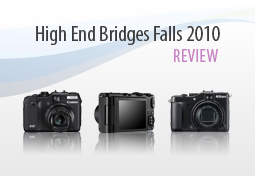


DXOMARK encourages its readers to share comments on the articles. To read or post comments, Disqus cookies are required. Change your Cookies Preferences and read more about our Comment Policy.